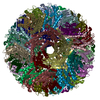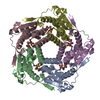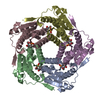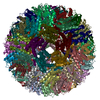+ Open data
Open data
- Basic information
Basic information
| Entry | Database: PDB / ID: 5mpp | ||||||
|---|---|---|---|---|---|---|---|
| Title | Structure of AaLS-wt | ||||||
 Components Components | 6,7-dimethyl-8-ribityllumazine synthase Lumazine synthase Lumazine synthase | ||||||
 Keywords Keywords |  TRANSFERASE / TRANSFERASE /  cryo-EM / protein cage / cryo-EM / protein cage /  dodecahedron / dodecahedron /  lumazine synthase lumazine synthase | ||||||
| Function / homology |  Function and homology information Function and homology information 6,7-dimethyl-8-ribityllumazine synthase / 6,7-dimethyl-8-ribityllumazine synthase /  6,7-dimethyl-8-ribityllumazine synthase activity / 6,7-dimethyl-8-ribityllumazine synthase activity /  riboflavin synthase complex / riboflavin biosynthetic process / riboflavin synthase complex / riboflavin biosynthetic process /  cytosol cytosolSimilarity search - Function | ||||||
| Biological species |    Aquifex aeolicus (bacteria) Aquifex aeolicus (bacteria) | ||||||
| Method |  ELECTRON MICROSCOPY / ELECTRON MICROSCOPY /  single particle reconstruction / single particle reconstruction /  cryo EM / Resolution: 3.9 Å cryo EM / Resolution: 3.9 Å | ||||||
 Authors Authors | Sasaki, E. / Boehringer, D. / Leibundgut, M. / Ban, N. / Hilvert, D. | ||||||
| Funding support |  Switzerland, 1items Switzerland, 1items
| ||||||
 Citation Citation |  Journal: Nat Commun / Year: 2017 Journal: Nat Commun / Year: 2017Title: Structure and assembly of scalable porous protein cages. Authors: Eita Sasaki / Daniel Böhringer / Michiel van de Waterbeemd / Marc Leibundgut / Reinhard Zschoche / Albert J R Heck / Nenad Ban / Donald Hilvert /   Abstract: Proteins that self-assemble into regular shell-like polyhedra are useful, both in nature and in the laboratory, as molecular containers. Here we describe cryo-electron microscopy (EM) structures of ...Proteins that self-assemble into regular shell-like polyhedra are useful, both in nature and in the laboratory, as molecular containers. Here we describe cryo-electron microscopy (EM) structures of two versatile encapsulation systems that exploit engineered electrostatic interactions for cargo loading. We show that increasing the number of negative charges on the lumenal surface of lumazine synthase, a protein that naturally assembles into a ∼1-MDa dodecahedron composed of 12 pentamers, induces stepwise expansion of the native protein shell, giving rise to thermostable ∼3-MDa and ∼6-MDa assemblies containing 180 and 360 subunits, respectively. Remarkably, these expanded particles assume unprecedented tetrahedrally and icosahedrally symmetric structures constructed entirely from pentameric units. Large keyhole-shaped pores in the shell, not present in the wild-type capsid, enable diffusion-limited encapsulation of complementarily charged guests. The structures of these supercharged assemblies demonstrate how programmed electrostatic effects can be effectively harnessed to tailor the architecture and properties of protein cages. | ||||||
| History |
|
- Structure visualization
Structure visualization
| Movie |
 Movie viewer Movie viewer |
|---|---|
| Structure viewer | Molecule:  Molmil Molmil Jmol/JSmol Jmol/JSmol |
- Downloads & links
Downloads & links
- Download
Download
| PDBx/mmCIF format |  5mpp.cif.gz 5mpp.cif.gz | 1.6 MB | Display |  PDBx/mmCIF format PDBx/mmCIF format |
|---|---|---|---|---|
| PDB format |  pdb5mpp.ent.gz pdb5mpp.ent.gz | 1.4 MB | Display |  PDB format PDB format |
| PDBx/mmJSON format |  5mpp.json.gz 5mpp.json.gz | Tree view |  PDBx/mmJSON format PDBx/mmJSON format | |
| Others |  Other downloads Other downloads |
-Validation report
| Arichive directory |  https://data.pdbj.org/pub/pdb/validation_reports/mp/5mpp https://data.pdbj.org/pub/pdb/validation_reports/mp/5mpp ftp://data.pdbj.org/pub/pdb/validation_reports/mp/5mpp ftp://data.pdbj.org/pub/pdb/validation_reports/mp/5mpp | HTTPS FTP |
|---|
-Related structure data
| Related structure data |  3538MC  3543C  3544C  5mq3C  5mq7C M: map data used to model this data C: citing same article ( |
|---|---|
| Similar structure data |
- Links
Links
- Assembly
Assembly
| Deposited unit | 
|
|---|---|
| 1 |
|
- Components
Components
| #1: Protein |  Lumazine synthase / Lumazine synthase Lumazine synthase / Lumazine synthaseMass: 16728.186 Da / Num. of mol.: 60 Source method: isolated from a genetically manipulated source Source: (gene. exp.)    Aquifex aeolicus (bacteria) / Gene: ribH, aq_132 / Production host: Aquifex aeolicus (bacteria) / Gene: ribH, aq_132 / Production host:   Escherichia coli (E. coli) Escherichia coli (E. coli)References: UniProt: O66529,  6,7-dimethyl-8-ribityllumazine synthase 6,7-dimethyl-8-ribityllumazine synthase |
|---|
-Experimental details
-Experiment
| Experiment | Method:  ELECTRON MICROSCOPY ELECTRON MICROSCOPY |
|---|---|
| EM experiment | Aggregation state: PARTICLE / 3D reconstruction method:  single particle reconstruction single particle reconstruction |
- Sample preparation
Sample preparation
| Component | Name: AaLS-wt / Type: COMPLEX / Entity ID: all / Source: RECOMBINANT |
|---|---|
| Molecular weight | Experimental value: NO |
| Source (natural) | Organism:    Aquifex aeolicus (bacteria) Aquifex aeolicus (bacteria) |
| Source (recombinant) | Organism:   Escherichia coli (E. coli) / Plasmid Escherichia coli (E. coli) / Plasmid : na : na |
| Buffer solution | pH: 7.8 |
| Specimen | Embedding applied: NO / Shadowing applied: NO / Staining applied : NO / Vitrification applied : NO / Vitrification applied : YES : YES |
Vitrification | Cryogen name: ETHANE |
- Electron microscopy imaging
Electron microscopy imaging
| Experimental equipment |  Model: Titan Krios / Image courtesy: FEI Company |
|---|---|
| Microscopy | Model: FEI TITAN KRIOS |
| Electron gun | Electron source : :  FIELD EMISSION GUN / Accelerating voltage: 300 kV / Illumination mode: FLOOD BEAM FIELD EMISSION GUN / Accelerating voltage: 300 kV / Illumination mode: FLOOD BEAM |
| Electron lens | Mode: BRIGHT FIELD Bright-field microscopy Bright-field microscopy |
| Image recording | Electron dose: 4 e/Å2 / Film or detector model: FEI FALCON II (4k x 4k) |
- Processing
Processing
| Software | Name: PHENIX / Version: (1.10-2155_1692: ???) / Classification: refinement | ||||||||||||||||||||||||||||
|---|---|---|---|---|---|---|---|---|---|---|---|---|---|---|---|---|---|---|---|---|---|---|---|---|---|---|---|---|---|
| EM software |
| ||||||||||||||||||||||||||||
CTF correction | Type: PHASE FLIPPING AND AMPLITUDE CORRECTION | ||||||||||||||||||||||||||||
| Symmetry | Point symmetry : I (icosahedral : I (icosahedral ) ) | ||||||||||||||||||||||||||||
3D reconstruction | Resolution: 3.9 Å / Resolution method: FSC 0.143 CUT-OFF / Num. of particles: 3268 / Symmetry type: POINT | ||||||||||||||||||||||||||||
| Refinement | Resolution: 3.94→252 Å / SU ML: 0.74 / σ(F): 1.99 / Phase error: 24.11 / Stereochemistry target values: MLHL
| ||||||||||||||||||||||||||||
| Solvent computation | Shrinkage radii: 0.9 Å / VDW probe radii: 1.11 Å / Solvent model: FLAT BULK SOLVENT MODEL | ||||||||||||||||||||||||||||
| Refine LS restraints |
|
 Movie
Movie Controller
Controller












 PDBj
PDBj
